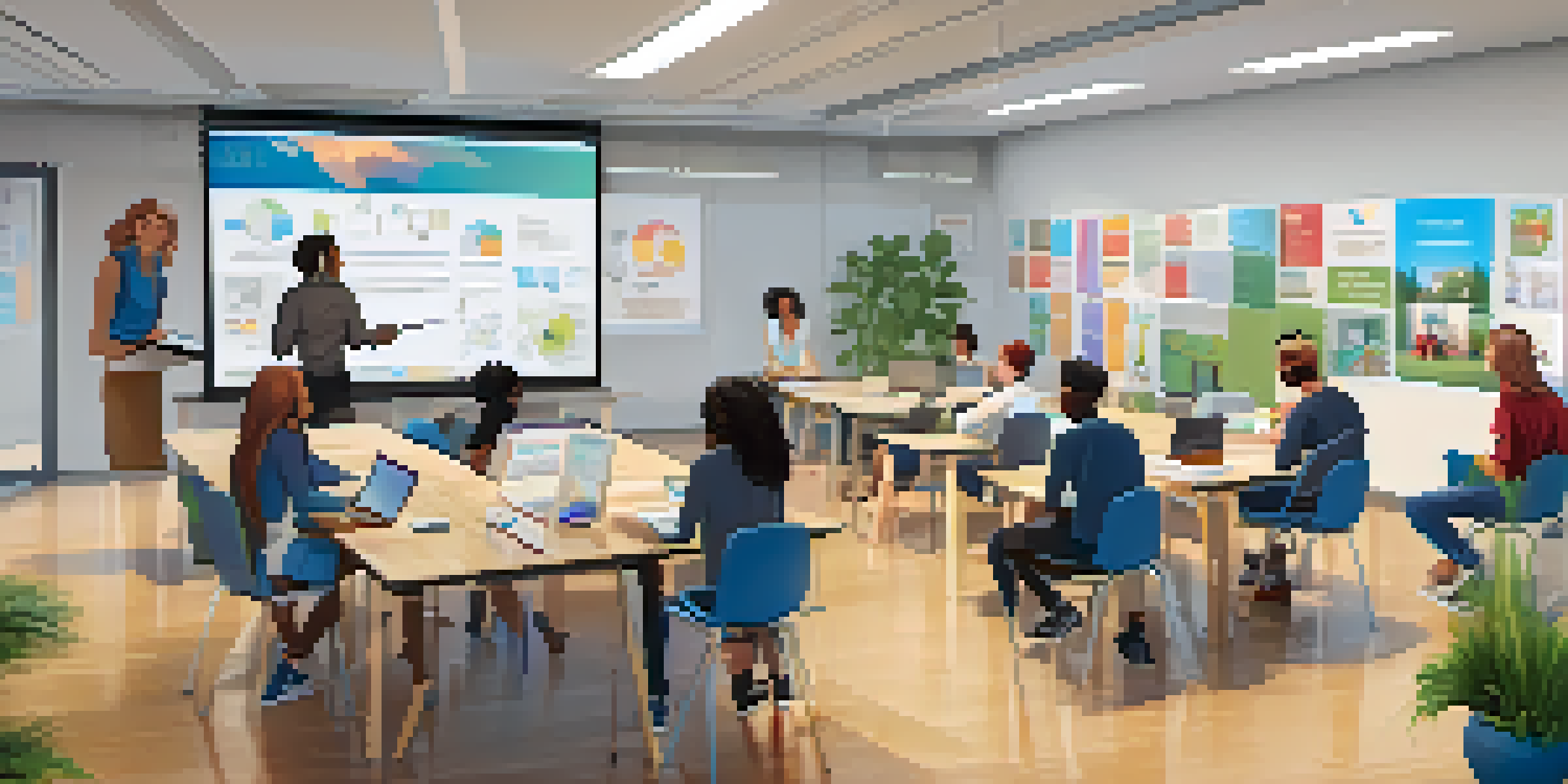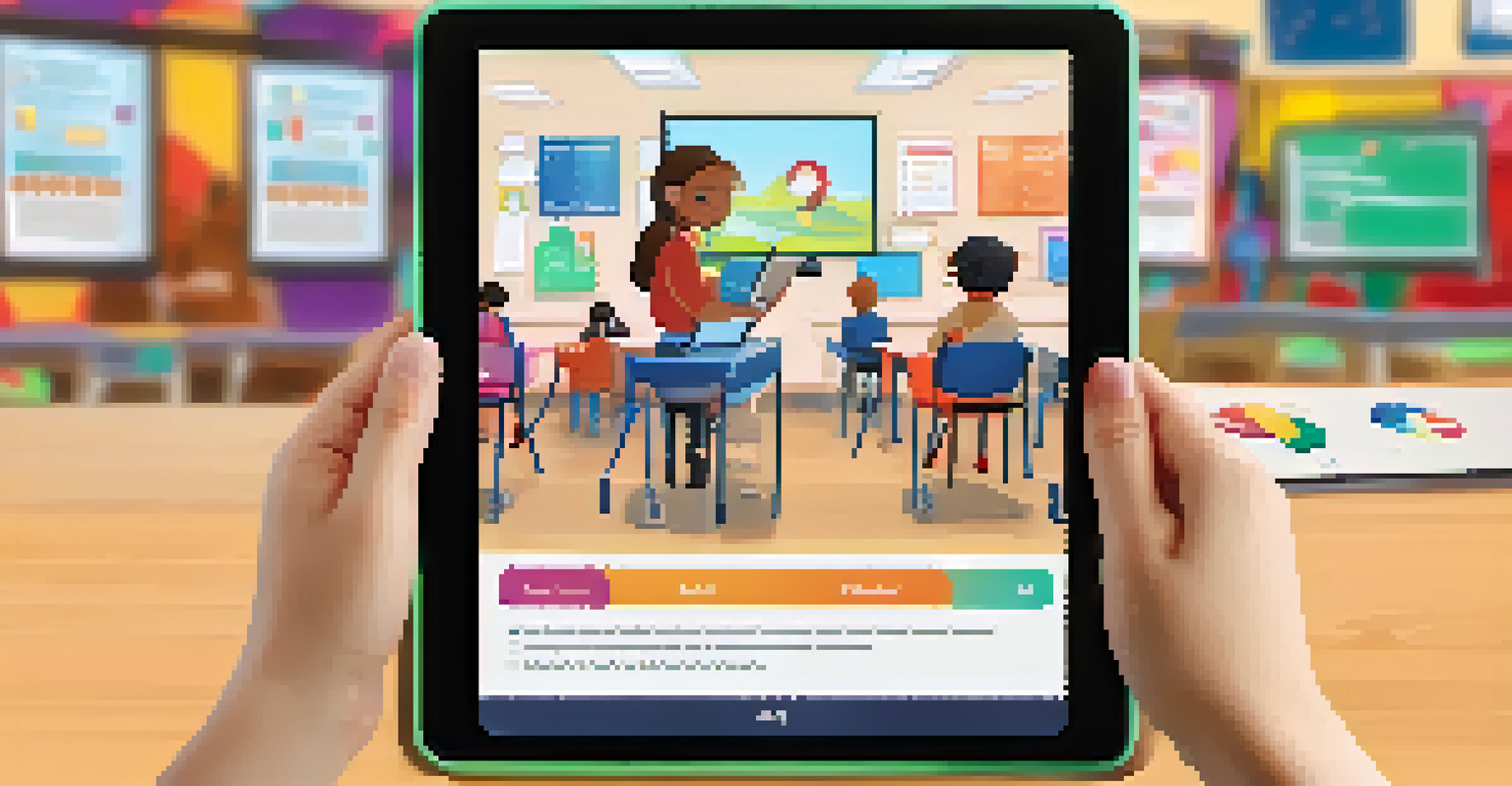Role of Technology in Creating Hybrid Learning Environments

Understanding Hybrid Learning: A Blended Approach
Hybrid learning combines traditional face-to-face instruction with online elements, creating a flexible environment for learners. This blend allows educators to reach students in diverse ways, catering to different learning styles. For instance, a student might attend a live class while accessing recorded lectures or interactive online resources at their own pace.
Education is not the filling of a pail, but the lighting of a fire.
The versatility of hybrid learning means that students can engage with materials in various formats, whether through video, discussions, or hands-on activities. This approach not only enhances understanding but also encourages greater participation from students. Moreover, it prepares learners for a future where digital skills are increasingly vital.
As education continues to evolve, hybrid learning stands out as a solution that addresses the needs of both students and educators. By leveraging technology, we can create an enriching experience that fosters collaboration, creativity, and critical thinking.
Key Technologies Powering Hybrid Learning
A variety of technologies play crucial roles in developing effective hybrid learning environments. Platforms like Learning Management Systems (LMS) enable educators to manage course materials and track student progress seamlessly. These systems ensure that resources are readily available, fostering a smooth learning experience whether students are in class or online.

Video conferencing tools, such as Zoom or Microsoft Teams, have become essential for real-time interaction between teachers and students. They allow for live discussions, Q&A sessions, and group collaborations, ensuring that everyone feels connected regardless of their physical location. This immediate access to instructors enriches the learning experience and builds community.
Hybrid Learning Enhances Flexibility
By combining in-person instruction with online elements, hybrid learning creates a versatile environment that caters to diverse learning styles.
Additionally, interactive tools like quizzes and forums enhance engagement and provide instant feedback. By using these technologies, educators can create a dynamic learning atmosphere that encourages participation and self-directed learning, vital components in a hybrid setting.
The Importance of Accessibility in Hybrid Learning
Accessibility is a cornerstone of effective hybrid learning; it ensures that all students, regardless of their backgrounds or abilities, can participate fully. Technology plays a significant role in making education more inclusive, offering various ways to tailor learning experiences. For instance, screen readers and captioning services help students with disabilities engage with content more effectively.
The great aim of education is not knowledge but action.
Moreover, hybrid learning environments can address geographical barriers, allowing students from remote or underserved areas to access quality education. With just an internet connection, learners can join classes, interact with peers, and receive support from educators, breaking down traditional barriers to education.
Ultimately, prioritizing accessibility in hybrid learning not only benefits individual students but also enriches the entire learning community. When everyone can participate, diverse perspectives are shared, and collective learning is enhanced, leading to a more vibrant educational experience.
Engaging Students Through Interactive Learning Tools
Interactive learning tools are vital for keeping students engaged in hybrid environments. Whether through polls, quizzes, or collaborative projects, these tools promote active participation, making learning more enjoyable and effective. For example, platforms like Kahoot! allow teachers to create fun quizzes that students can join in real-time, fostering a sense of competition and collaboration.
Additionally, gamification—integrating game elements into learning—can significantly boost motivation. By incorporating points, badges, or leaderboards, educators can encourage students to complete tasks and engage more deeply with the material. This playful approach to learning appeals to students of all ages, making education feel more like an adventure.
Technology Boosts Engagement
Interactive tools and data analytics play a crucial role in maintaining student engagement and personalizing learning experiences in hybrid settings.
Ultimately, using interactive tools in hybrid learning not only enhances engagement but also aids in knowledge retention. When students are actively involved in their learning process, they are more likely to grasp complex concepts and apply them in real-world situations.
The Role of Data Analytics in Hybrid Learning
Data analytics is transforming how educators assess and enhance hybrid learning experiences. By tracking student performance and engagement levels, educators can identify trends and tailor their teaching strategies accordingly. For instance, if data shows that students struggle with specific topics, instructors can adjust their focus to provide additional support.
Furthermore, analytics can help educators personalize learning paths for individual students. By understanding each learner's strengths and weaknesses, teachers can offer customized resources and support, ensuring that every student progresses at their own pace. This personalized approach is particularly beneficial in hybrid settings, where learners may have different levels of access and engagement.
Ultimately, leveraging data analytics in hybrid learning empowers educators to make informed decisions that enhance the overall educational experience. By using insights from data, teachers can create a more responsive and effective learning environment.
Challenges of Implementing Hybrid Learning
While hybrid learning offers numerous benefits, it also comes with its fair share of challenges. One major obstacle is ensuring that all students have equal access to technology and stable internet connections. Without reliable access, some students may fall behind, creating disparities in learning outcomes that educators must address.
Additionally, maintaining student engagement can be tricky in a hybrid environment. Some learners may feel disconnected during online portions of the course, leading to lower participation and motivation. Educators must find innovative ways to keep students involved, such as incorporating interactive elements and fostering a sense of community.
Accessibility Is Essential
Prioritizing accessibility in hybrid learning ensures that all students can participate fully, fostering a more inclusive and enriched educational community.
Finally, training teachers to effectively use technology in hybrid learning is essential. Many educators may not be familiar with the latest tools or how to integrate them into their teaching effectively. Ongoing professional development and support can help bridge this gap, ensuring that instructors feel confident and competent in delivering a hybrid curriculum.
The Future of Hybrid Learning and Technology
The future of hybrid learning looks promising as technology continues to evolve and reshape education. With advancements in artificial intelligence and virtual reality, we can expect even more immersive and personalized learning experiences. Imagine students exploring historical sites through virtual field trips or receiving tailored feedback from AI-driven platforms.
Moreover, as educational institutions adapt to changing needs, hybrid learning models are likely to become more commonplace. This shift toward flexible learning environments will prepare students for a workforce that increasingly values adaptability and digital literacy. Educators will play a crucial role in guiding this transition, ensuring that technology enhances the learning experience.

Ultimately, embracing technology in hybrid learning environments can lead to more equitable, engaging, and effective educational experiences. As we move forward, it's essential to keep the focus on student needs, ensuring that every learner has the opportunity to thrive in a digital and blended world.